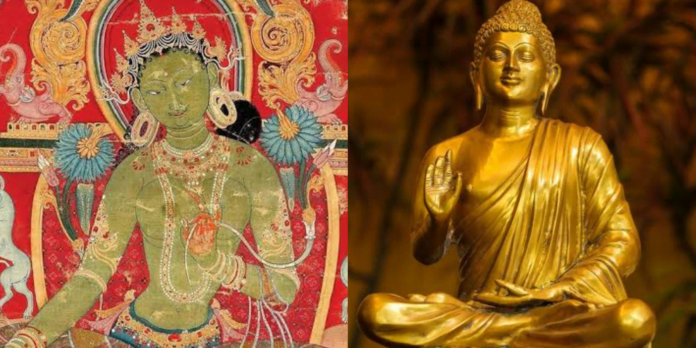Buddhist art encompasses visual representations linked to Buddhism, featuring depictions of Gautama Buddha, bodhisattvas, historical and mythical figures, narrative scenes from their lives, mandalas, and objects tied to Buddhist practice like vajras, bells, stupas, and temple architecture. Its roots trace back to the northern Indian subcontinent, particularly in modern-day India, Pakistan, and Afghanistan, with surviving artefacts dating from a few centuries after Siddhartha Gautama’s historical existence in the 6th to 5th century BCE.
As Buddhism spread and adapted in various host countries, Buddhist art evolved alongside it. The Northern branch of Buddhist art emerged as it extended through Central Asia into Eastern Asia, while the Southern branch reached as far as Southeast Asia. In India, Buddhist art thrived, coexisting and influencing Hindu and Jain art within shared cave temple complexes. Initially centered on devotional statues and detailed reliefs depicting the life of the historical Buddha, the focus shifted over time. The Buddhist pantheon expanded, leading to devotional images of bodhisattvas and other figures becoming primary subjects in Northern Buddhist art by the late first millennium, rather than mere attendants of the Buddha.
History
Pre-iconic Phase (5th – 1st century BCE)
Between the 2nd and 1st century BCE, explicit sculptures illustrating episodes from the Buddha’s life emerged, mainly as votive tablets or friezes on stupas. Despite India’s sculptural tradition, artists hesitated to portray the Buddha anthropomorphically, relying on aniconic symbols until the 2nd century CE, notably in the Amaravati School. Speculation surrounds earlier human representations, possibly in wood, but lacks archaeological support.
Buddhist art in India originated in the 1st century BCE, exemplified by the Mahabodhi Temple in Bodh Gaya, influencing structures in Burma and Indonesia. Notably, Sigiriya’s frescoes are considered older than those at the Ajanta Caves.
Iconic phase (1st century BCE – present)
The historical narrative traces back to Zhang Qian’s 130 BCE travels and Emperor Han Wudi’s 2nd century BCE worship of Buddha statues, suggesting their existence in the 2nd century BCE. Anthropomorphic Buddha representations emerged in Northern India from the 1st century CE, with key centers in Gandhara, Amaravati, and Mathura. The Indo-Greek and Greco-Bactrian Kingdoms propagated Greco-Buddhist art in north-western India, with King Menander I as a notable Buddhist patron.
Persecution under Pushyamitra Shunga led to the decline of Buddhist art east of Mathura. Gandharan Buddhist sculpture, influenced by Hellenistic art, featured larger and more naturalistic figures. Mathura’s art, rooted in Indian tradition, introduced distinctive features.
Mathura and Gandhara influenced each other during the Kushan Empire, and the origin of anthropomorphic Buddha representations is debated between local evolution in Mathura and Greco-Buddhist syncretism in Gandhara.
Early iconic Buddhist art set a standard portraying the Buddha with realistic human features. Surviving paintings, mainly from Ajanta Caves, showcased sophistication until around 480 CE. Gupta period sculptures in Mathura influenced Asia. By the 12th century CE, Buddhism thrived in the Himalayan regions, with influences from Tibet and China evident in Ladakh’s art. As Buddhism spread beyond India from the 1st century CE, its artistic expressions blended with diverse influences, resulting in a gradual divergence among adopting countries.
Northern Buddhist Art
The transmission of Buddhism along the Silk Road began in the 1st century CE, with an embassy sent by the Chinese Emperor Ming. However, significant contacts started in the 2nd century CE due to the expansion of the Kushan Empire into the Chinese Tarim Basin. Central Asian Buddhist monks, including Parthian, Kushan, Sogdian, and Kuchean, played a pivotal role as missionaries and translators, with figures like Lokaksema.
This cultural exchange also influenced Serindian art in the Tarim Basin, reflecting Greco-Buddhist styles from the Gandhara district, combining Indian, Greek, and Roman elements. The northern route’s art, shaped by Mahāyāna Buddhism, embraced a broader perspective, emphasizing the bodhisattva path and featuring a diverse pantheon devoted to ultimate knowledge, enlightenment, and the liberation of all sentient beings.
Northern Buddhist art is characterized by a rich and syncretic pantheon, showcasing various buddhas, bodhisattvas, and heavenly beings, reflecting the Mahāyāna emphasis on transcendent and infinite aspects of Buddhism. This artistic and cultural interchange along the Silk Road left a lasting impact, with potential influences on the Japanese god Fūjin.
Southern Buddhist Art
Over a millennium, Southern Buddhism, practiced in Sri Lanka, Myanmar, Thailand, Laos, and Cambodia, flourished through Indian influence. The overland Silk Road faced constraints due to the Parthian Empire’s rise, prompting a shift to sea connections, driven by Rome’s increasing demand for Asian luxuries. India played a crucial role in transmitting languages, Buddhism, Brahmanism, and Hinduism to Southeast Asia, shaping the region’s cultural unity and artistic evolution.
Between the 1st and 8th centuries, various kingdoms, like Cambodian Funan and Burmese Mon, competed, contributing diverse artistic features rooted in the Indian Gupta style. Under the Pala dynasty (8th-12th century), Buddhism and Hinduism intertwined. The Muslim invasion led by the 14th century contributed to the decline of Buddhism in India.
In the 8th-9th centuries, Shailendran Buddhist art thrived in Central Java, Indonesia, with monuments like Borobudur. From the 9th-13th centuries, powerful Southeast Asian empires, Sri Vijaya and Khmer, competed, expressing Mahayana Buddhism’s pantheon. Theravada Buddhism was introduced in the 13th century, influencing the Thai kingdom of Sukhothai. Temple complexes played a vital role in artistic expression.
By the 14th century, Islam spread in maritime Southeast Asia, impacting Malaysia and Indonesia. In continental areas, Theravada Buddhism expanded into Burma, Laos, and Cambodia.


